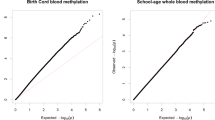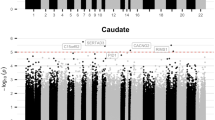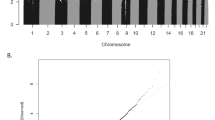Abstract
Attention-deficit/hyperactivity disorder (ADHD) is a prevalent developmental disorder, associated with a range of long-term impairments. Variation in DNA methylation, an epigenetic mechanism, is implicated in both neurobiological functioning and psychiatric health. However, the potential role of DNA methylation in ADHD symptoms is currently unclear. In this study, we examined data from the Avon Longitudinal Study of Parents and Children (ALSPAC)—specifically the subsample forming the Accessible Resource for Integrated Epigenomics Studies (ARIES)—that includes (1) peripheral measures of DNA methylation (Illumina 450k) at birth (n=817, 49% male) and age 7 (n=892, 50% male) and (2) trajectories of ADHD symptoms (7–15 years). We first employed a genome-wide analysis to test whether DNA methylation at birth associates with later ADHD trajectories; and then followed up at age 7 to investigate the stability of associations across early childhood. We found that DNA methylation at birth differentiated ADHD trajectories across multiple genomic locations, including probes annotated to SKI (involved in neural tube development), ZNF544 (previously implicated in ADHD), ST3GAL3 (linked to intellectual disability) and PEX2 (related to perixosomal processes). None of these probes maintained an association with ADHD trajectories at age 7. Findings lend novel insights into the epigenetic landscape of ADHD symptoms, highlighting the potential importance of DNA methylation variation in genes related to neurodevelopmental and peroxisomal processes that play a key role in the maturation and stability of cortical circuits.
This is a preview of subscription content, access via your institution
Access options
Subscribe to this journal
Receive 12 print issues and online access
$259.00 per year
only $21.58 per issue
Buy this article
- Purchase on Springer Link
- Instant access to full article PDF
Prices may be subject to local taxes which are calculated during checkout



Similar content being viewed by others
References
Willcutt EG . The prevalence of DSM-IV attention-deficit/hyperactivity disorder: a meta-analytic review. Neurotherapeutics 2012; 9: 490–499.
Franke B, Faraone SV, Asherson P, Buitelaar J, Bau CHD, Ramos-Quiroga JA et al. The genetics of Attention Deficit/Hyperactivity Disorder in adults, a review. Mol Psychiatry 2012; 17: 960–987.
Mannuzza S, Klein RG, Moulton JL III . Lifetime criminality among boys with attention deficit hyperactivity disorder: a prospective follow-up study into adulthood using official arrest records. Psychiatry Res 2008; 160: 237–246.
Polderman TJC, Boomsma DI, Bartels M, Verhulst FC, Huizink AC . A systematic review of prospective studies on attention problems and academic achievement. Acta Psychiatr Scand 2010; 122: 271–284.
Pingault J-B, Tremblay RE, Vitaro F, Carbonneau R, Genolini C, Falissard B et al. Childhood trajectories of inattention and hyperactivity and prediction of educational attainment in early adulthood: a 16-year longitudinal population-based study. Am J Psychiatry 2011; 168: 1164–1170.
Pingault J-B, Côté S, Galéra C, Genolini C, Falissard B, Vitaro F et al. Childhood trajectories of inattention, hyperactivity and oppositional behaviors and prediction of substance abuse/dependence: a 15-year longitudinal population-based study. Mol Psychiatry 2013; 18: 806–812.
Foulon S, Pingault J-B, Larroque B, Melchior M, Falissard B, Côté SM . Developmental predictors of inattention-hyperactivity from pregnancy to early childhood. PLoS One 2015; 10: e0125996.
Galéra C, Côté SM, Bouvard MP, Pingault J-B, Melchior M, Michel G et al. Early risk factors for hyperactivity-impulsivity and inattention trajectories from age 17 months to 8 years. Arch Gen Psychiatry 2011; 68: 1267–1275.
Chang Z, Lichtenstein P, Asherson PJ, Larsson H . Developmental twin study of attention problems: high heritabilities throughout development. JAMA Psychiatry 2013; 70: 311–318.
Merwood A, Asherson P . Attention deficit hyperactivity disorder: a lifespan genetic perspective. Adv Ment Health Intellect Disabil 2011; 5: 33–46.
Pingault J-B, Viding E, Galéra C, Greven CU, Zheng Y, Plomin R et al. Genetic and environmental influences on the developmental course of attention-deficit/hyperactivity disorder symptoms from childhood to adolescence. JAMA Psychiatry 2015; 72: 651–658.
Neale BM, Medland SE, Ripke S, Asherson P, Franke B, Lesch K-P et al. Meta-analysis of genome-wide association studies of attention-deficit/hyperactivity disorder. J Am Acad Child Adolesc Psychiatry 2010; 49: 884–897.
Yang L, Neale BM, Liu L, Lee SH, Wray NR, Ji N et al. Polygenic transmission and complex neurodevelopmental network for attention deficit hyperactivity disorder: genome-wide association study of both common and rare variants. Am J Med Genet B Neuropsychiatr Genet 2013; 162B: 419–430.
Cecil CaM, Lysenko LJ, Jaffee SR, Pingault J-B, Smith RG, Relton CL et al. Environmental risk, Oxytocin Receptor Gene (OXTR) methylation and youth callous-unemotional traits: a 13-year longitudinal study. Mol Psychiatry 2014; 19: 1071–1077.
Mill J, Petronis A . Pre- and peri-natal environmental risks for attention-deficit hyperactivity disorder (ADHD): the potential role of epigenetic processes in mediating susceptibility. J Child Psychol Psychiatry 2008; 49: 1020–1030.
Lutz P-E, Turecki G . DNA methylation and childhood maltreatment: from animal models to human studies. Neuroscience 2014; 264: 142–156.
McRae AF, Powell JE, Henders AK, Bowdler L, Hemani G, Shah S et al. Contribution of genetic variation to transgenerational inheritance of DNA methylation. Genome Biol 2014; 15: 1–10.
Van Mil NH, Steegers-Theunissen RPM, Bouwland-Both MI, Verbiest MMPJ, Rijlaarsdam J, Hofman A et al. DNA methylation profiles at birth and child ADHD symptoms. J Psychiatr Res 2014; 49: 51–59.
Xu Y, Chen X-T, Luo M, Tang Y, Zhang G, Wu D et al. Multiple epigenetic factors predict the attention deficit/hyperactivity disorder among the Chinese Han children. J Psychiatr Res 2015; 64: 40–50.
Sullivan PF . The Psychiatric GWAS Consortium: big science comes to psychiatry. Neuron 2010; 68: 182–186.
Wilmot B, Fry R, Smeester L, Musser ED, Mill J, Nigg JT . Methylomic analysis of salivary DNA in childhood ADHD identifies altered DNA methylation in VIPR2. J Child Psychol Psychiatry 2015; 57: 152–160.
Relton CL, Gaunt T, McArdle W, Ho K, Duggirala A, Shihab H et al. Data Resource Profile: Accessible Resource for Integrated Epigenomic Studies (ARIES). Int J Epidemiol 2015; 44: 1181–1190.
Fraser A, Macdonald-Wallis C, Tilling K, Boyd A, Golding J, Davey Smith G et al. Cohort Profile: The Avon Longitudinal Study of Parents and Children: ALSPAC mothers cohort. Int J Epidemiol 2013; 42: 97–110.
Boyd A, Golding J, Macleod J, Lawlor DA, Fraser A, Henderson J et al. Cohort Profile: the ‘children of the 90s’—the index offspring of the Avon Longitudinal Study of Parents and Children. Int J Epidemiol 2013; 42: 111–127.
Goodman A, Heiervang E, Collishaw S, Goodman R . The ‘DAWBA bands’ as an ordered-categorical measure of child mental health: description and validation in British and Norwegian samples. Soc Psychiatry Psychiatr Epidemiol 2011; 46: 521–532.
Chen Y, Lemire M, Choufani S, Butcher DT, Grafodatskaya D, Zanke BW et al. Discovery of cross-reactive probes and polymorphic CpGs in the Illumina Infinium HumanMethylation450 microarray. Epigenetics 2013; 8: 203–209.
Price EM, Cotton AM, Lam LL, Farré P, Emberly E, Brown CJ et al. Additional annotation enhances potential for biologically-relevant analysis of the Illumina Infinium HumanMethylation450 BeadChip array. Epigenetics Chromatin 2013; 6: 4.
Houseman EA, Accomando WP, Koestler DC, Christensen BC, Marsit CJ, Nelson HH et al. DNA methylation arrays as surrogate measures of cell mixture distribution. BMC Bioinformatics 2012; 13: 86.
Genolini C, Falissard B . KmL: a package to cluster longitudinal data. Comput Methods Programs Biomed 2011; 104: e112–e121.
Hartigan JA, Wong MA . Algorithm AS 136: a k-means clustering algorithm. J R Stat Soc C (Appl Stat) 1979; 28: 100–108.
Genolini C, Falissard B . KmL: k-means for longitudinal data. Comput Stat 2010; 25: 317–328.
Wang D, Yan L, Hu Q, Sucheston LE, Higgins MJ, Ambrosone CB et al. IMA: an R package for high-throughput analysis of Illumina’s 450K Infinium methylation data. Bioinformatics 2012; 28: 729–730.
Warde-Farley D, Donaldson SL, Comes O, Zuberi K, Badrawi R, Chao P et al. The GeneMANIA prediction server: biological network integration for gene prioritization and predicting gene function. Nucleic Acids Res 2010; 38: W214–W220.
Mostafavi S, Ray D, Warde-Farley D, Grouios C, Morris Q . GeneMANIA: a real-time multiple association network integration algorithm for predicting gene function. Genome Biol 2008; 9 (Suppl 1): S4.
Amaravadi LS, Neff AW, Sleeman JP, Smith RC . Autonomous neural axis formation by ectopic expression of the protooncogene c-ski. Dev Biol 1997; 192: 392–404.
Chen D, Lin Q, Box N, Roop D, Ishii S, Matsuzaki K et al. SKI knockdown inhibits human melanoma tumor growth in vivo. Pigment Cell Melanoma Res 2009; 22: 761–772.
Hu H, Eggers K, Chen W, Garshasbi M, Motazacker MM, Wrogemann K et al. ST3GAL3 Mutations Impair the Development of Higher Cognitive Functions. Am J Hum Genet 2011; 89: 407–414.
Lasky-Su J, Neale BM, Franke B, Anney RJL, Zhou K, Maller JB et al. Genome-wide association scan of quantitative traits for attention deficit hyperactivity disorder identifies novel associations and confirms candidate gene associations. Am J Med Genet 2008; 147B: 1345–1354.
Cecil CaM, Walton E, Viding E . Epigenetics of addiction: current knowledge, challenges and future directions. J Stud Alcohol Drugs 2016 (in press).
Masters C . Omega-3 fatty acids and the peroxisome. Mol Cell Biochem 1996; 165: 83–93.
Farooqui AA, Horrocks LA . Plasmalogens, phospholipase A2, and docosahexaenoic acid turnover in brain tissue. J Mol Neurosci 2001; 16: 263–272.
McNamara RK, Vannest JJ, Valentine CJ . Role of perinatal long-chain omega-3 fatty acids in cortical circuit maturation: mechanisms and implications for psychopathology. World J Psychiatry 2015; 5: 15–34.
Bloch MH, Qawasmi A . Omega-3 fatty acid supplementation for the treatment of children with attention-deficit/hyperactivity disorder symptomatology: systematic review and meta-analysis. J Am Acad Child Adolesc Psychiatry 2011; 50: 991–1000.
Hawkey E, Nigg JT . Omega-3 fatty acid and ADHD: blood level analysis and meta-analytic extension of supplementation trials. Clin Psychol Rev 2014; 34: 496–505.
Cooper RE, Tye C, Kuntsi J, Vassos E, Asherson P . Omega-3 polyunsaturated fatty acid supplementation and cognition: a systematic review and meta-analysis. J Psychopharmacol (Oxford) 2015; 29: 753–763.
Atanasoski S, Notterpek L, Lee H-Y, Castagner F, Young P, Ehrengruber MU et al. The protooncogene Ski controls Schwann cell proliferation and myelination. Neuron 2004; 43: 499–511.
Williams VC, Lucas J, Babcock MA, Gutmann DH, Korf B, Maria BL . Neurofibromatosis type 1 revisited. Pediatrics 2009; 123: 124–133.
Hyman SL, Shores A, North KN . The nature and frequency of cognitive deficits in children with neurofibromatosis type 1. Neurology 2005; 65: 1037–1044.
Najmabadi H, Motazacker MM, Garshasbi M, Kahrizi K, Tzschach A, Chen W et al. Homozygosity mapping in consanguineous families reveals extreme heterogeneity of non-syndromic autosomal recessive mental retardation and identifies 8 novel gene loci. Hum Genet 2007; 121: 43–48.
Kuss AW, Garshasbi M, Kahrizi K, Tzschach A, Behjati F, Darvish H et al. Autosomal recessive mental retardation: homozygosity mapping identifies 27 single linkage intervals, at least 14 novel loci and several mutation hotspots. Hum Genet 2011; 129: 141–148.
Numata S, Ye T, Hyde TM, Guitart-Navarro X, Tao R, Wininger M et al. DNA methylation signatures in development and aging of the human prefrontal cortex. Am J Hum Genet 2012; 90: 260–272.
Spiers H, Hannon E, Schalkwyk LC, Smith R, Wong CCY, O’Donovan MC et al. Methylomic trajectories across human fetal brain development. Genome Res 2015; 25: 338–352.
McCowan T, Dhasarathy A, Carvelli L . The epigenetic mechanisms of amphetamine. J Addict Prev 2015; available at: http://citeseerx.ist.psu.edu/viewdoc/download?doi=10.1.1.681.8437&rep=rep1&type=pdf (accessed 18 February 2016).
Pidsley R, Viana J, Hannon E, Spiers H, Troakes C, Al-Saraj S et al. Methylomic profiling of human brain tissue supports a neurodevelopmental origin for schizophrenia. Genome Biol 2014; 15: 483.
Dempster EL, Wong CCY, Lester KJ, Burrage J, Gregory AM, Mill J et al. Genome-wide methylomic analysis of monozygotic twins discordant for adolescent depression. Biol Psychiatry 2014; 76: 977–983.
Acknowledgements
We are extremely grateful to all the families who took part in this study, the midwives for their help in recruiting them and the whole ALSPAC team, including interviewers, computer and laboratory technicians, clerical workers, research scientists, volunteers, managers, receptionists and nurses. With regard to the ALSPAC DNA methylation, we thank all involved, particularly the laboratory scientists and bioinformaticians, who contributed considerable time and expertise to the data in this paper. The UK Medical Research Council and the Wellcome Trust (Grant Ref: 092731 to ED Barker and J Mill) and the University of Bristol provide core support for ALSPAC. This work was funded by the National Institute of Child and Human Development Grant (R01HD068437). ARIES was funded by the BBSRC (BBI025751/1 and BB/I025263/1). ARIES is maintained under the auspices of the MRC Integrative Epidemiology Unit at the University of Bristol (MC_UU_12013/2 and MC_UU_12013/8). Dr Walton is supported by the German Research Foundation. Dr Pingault is supported by a European Commission Marie Curie Intra-European Fellowship (No. 330699). Dr Cecil is supported by the Economic and Social Research Council (Grant Ref: ES/N001273/1).
Author information
Authors and Affiliations
Corresponding author
Ethics declarations
Competing interests
The authors declare no conflict of interest.
Additional information
Supplementary Information accompanies the paper on the Molecular Psychiatry website
Supplementary information
Rights and permissions
About this article
Cite this article
Walton, E., Pingault, JB., Cecil, C. et al. Epigenetic profiling of ADHD symptoms trajectories: a prospective, methylome-wide study. Mol Psychiatry 22, 250–256 (2017). https://doi.org/10.1038/mp.2016.85
Received:
Revised:
Accepted:
Published:
Issue Date:
DOI: https://doi.org/10.1038/mp.2016.85
This article is cited by
-
Gestational epigenetic age and ADHD symptoms in childhood: a prospective, multi-cohort study
Molecular Psychiatry (2024)
-
Cortico-striatal differences in the epigenome in attention-deficit/ hyperactivity disorder
Translational Psychiatry (2024)
-
Epigenome-wide association study identifies neonatal DNA methylation associated with two-year attention problems in children born very preterm
Translational Psychiatry (2024)
-
DNA methylation as a potential mediator of the association between indoor air pollution and neurodevelopmental delay in a South African birth cohort
Clinical Epigenetics (2023)
-
Transcriptional co-activators: emerging roles in signaling pathways and potential therapeutic targets for diseases
Signal Transduction and Targeted Therapy (2023)



